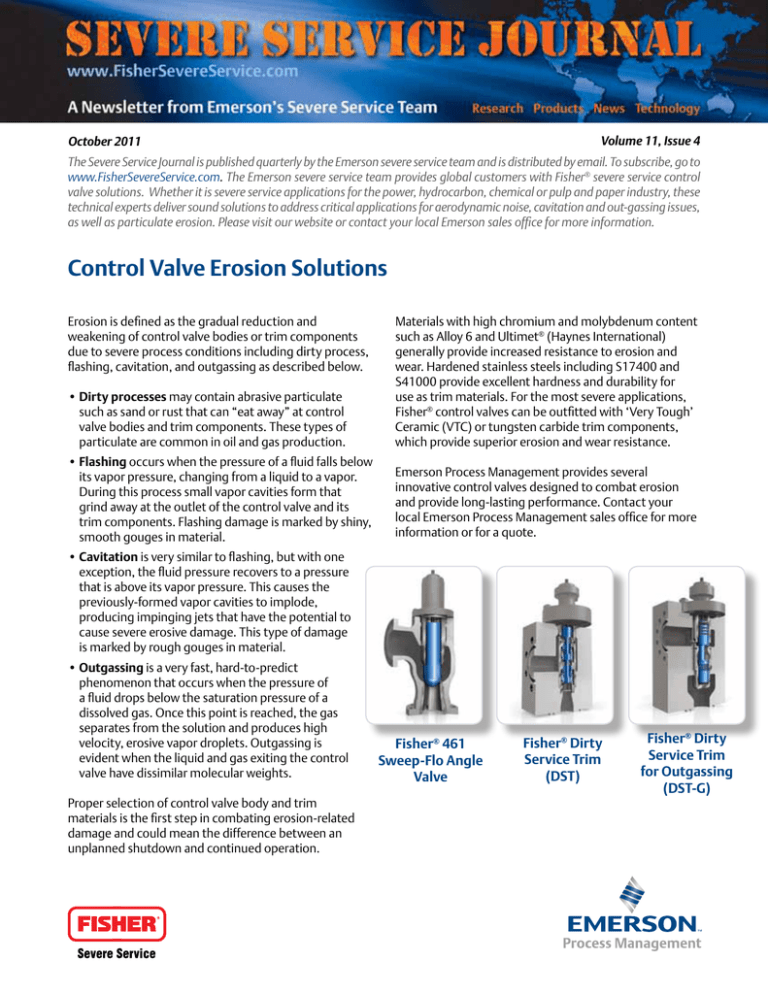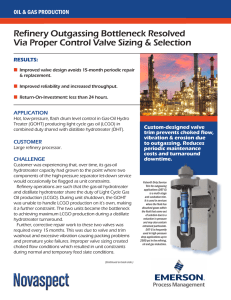
Volume 11, Issue 4
October 2011
The Severe Service Journal is published quarterly by the Emerson severe service team and is distributed by email. To subscribe, go to
www.FisherSevereService.com. The Emerson severe service team provides global customers with Fisher® severe service control
valve solutions. Whether it is severe service applications for the power, hydrocarbon, chemical or pulp and paper industry, these
technical experts deliver sound solutions to address critical applications for aerodynamic noise, cavitation and out-gassing issues,
as well as particulate erosion. Please visit our website or contact your local Emerson sales office for more information.
Control Valve Erosion Solutions
Erosion is defined as the gradual reduction and
weakening of control valve bodies or trim components
due to severe process conditions including dirty process,
flashing, cavitation, and outgassing as described below.
• Dirty processes may contain abrasive particulate
such as sand or rust that can “eat away” at control
valve bodies and trim components. These types of
particulate are common in oil and gas production.
Materials with high chromium and molybdenum content
such as Alloy 6 and Ultimet® (Haynes International)
generally provide increased resistance to erosion and
wear. Hardened stainless steels including S17400 and
S41000 provide excellent hardness and durability for
use as trim materials. For the most severe applications,
Fisher® control valves can be outfitted with ‘Very Tough’
Ceramic (VTC) or tungsten carbide trim components,
which provide superior erosion and wear resistance.
• Flashing occurs when the pressure of a fluid falls below
its vapor pressure, changing from a liquid to a vapor.
During this process small vapor cavities form that
grind away at the outlet of the control valve and its
trim components. Flashing damage is marked by shiny,
smooth gouges in material.
Emerson Process Management provides several
innovative control valves designed to combat erosion
and provide long-lasting performance. Contact your
local Emerson Process Management sales office for more
information or for a quote.
• Cavitation is very similar to flashing, but with one
exception, the fluid pressure recovers to a pressure
that is above its vapor pressure. This causes the
previously-formed vapor cavities to implode,
producing impinging jets that have the potential to
cause severe erosive damage. This type of damage
is marked by rough gouges in material.
• Outgassing is a very fast, hard-to-predict
phenomenon that occurs when the pressure of
a fluid drops below the saturation pressure of a
dissolved gas. Once this point is reached, the gas
separates from the solution and produces high
velocity, erosive vapor droplets. Outgassing is
evident when the liquid and gas exiting the control
valve have dissimilar molecular weights.
Proper selection of control valve body and trim
materials is the first step in combating erosion-related
damage and could mean the difference between an
unplanned shutdown and continued operation.
Fisher® 461
Sweep-Flo Angle
Valve
Fisher® Dirty
Service Trim
(DST)
Fisher® Dirty
Service Trim
for Outgassing
(DST-G)
Solution for Mining Industry Seawater Application
Seawater can be a difficult application if control valves
and materials have not been appropriately specified.
Due to the lack of water in the northern part of Chile,
a mining operation needed to pump seawater from
145 Kilometers away at an elevation of 0 to 2,300
meters above sea level for use in their process. To do
this, they constructed a 38” pipeline that included four
intermediate pump stations with tank level control at
each station.
INECO coordinated with the Fisher special products
group, metals and mining industry group, and
manufacturing group in Marshalltown, Iowa, U.S., to
manufacture the highly technical solution and deliver the
Fisher large easy-e valves in 26 weeks as requested by the
mining operation.
Since startup through the date of this publication,
the mining operation in northern Chile has been very
satisfied with its installation of Fisher large easy-e valves
in their seawater application.
Butterfly valves and ball valves were selected by the
mining operation for this application because of their
high capacity. They contacted INECO, the Emerson
Process Management local business partner for the
region, and asked for a quotation.
INECO personnel recognized that rotary valves would not
be a good fit for the seawater application with cavitation,
noise, and vibration problems. So after evaluating
different options, INECO quoted a long-term solution
using globe valves instead of the rotary valves. They
submitted a quote that included Fisher® NPS 24x20 large
easy-e™ globe valves with duplex stainless steel bodies
and trim material. These globe valves were four times
higher in price, but the mining operation accepted.
Your Emerson Process Management sales office
understands severe service problems and can provide
solutions to control them; even the most unusual of
problems can be solved.
Erosion/Corrosion Phenomena
Erosion/corrosion are high-velocity process conditions in
which a metal’s protective, passive layer is “washed off”
the surface, allowing the base material to corrode. The
synergistic effect results in very high rates of attack.
Erosion/corrosion are common phenomena that can
occur in nearly any industry where corrosive fluids are
present and are flowing with some velocity. Thin pipes,
blown out elbows, and eroded control valve bodies are
often the result.
Various industries refer to these problems with different
terms but the cause and the solution are generally the
same. For instance, in the power industry, erosion/
corrosion are often referred to as Flow Accelerated
Corrosion (FAC). FAC is a common problem due to
improper water chemistry that results in magnetite-related
issues in control valve bodies, piping, and boiler tubes.
Generally, erosion/corrosion can be controlled by
changing the materials of construction to ones that are
more corrosion resistant and compatible with the fluid.
An example of this would be replacing a carbon steel
body with 316SST.
Other times, changes to the control valve design may
produce the best results. This is commonly seen when
upgrading a Fisher® Cavitrol™ III trim set to utilize
Protected Inside Seat technology. With this design
change, the seating surface is moved to the inside of the
plug where it is protected from the high velocities that
can occur in between the plug and cage. The outcome
is long-term shutoff without the damaging effects of
erosion/corrosion.
Whatever the cause of your erosion/corrosion issues,
Emerson Process Management has the expertise and
solutions to solve your difficult problems.
In control valves, erosion/corrosion problems are
exhibited in a variety of ways. Sometimes, valve bodies
are washed away as can been seen in Figures 1 and 2.
Other times, problems result in trim damage as seen in
Figure 3.
Figure 1
Figure 2
Figure 3
Valve Trim Erosion Eliminated in Level Control Valve
A stabilizer feed drum inlet level control valve was
causing frequent disruption to a refinery’s operation
and impacting efficiency due to severe erosion of the
valve trim.
Before oil can be shipped from an offshore platform for
sale or for production, impurities such as water and gas
must be removed by means of a separator. During this
process the oil is floated on top of a column of water,
which is controlled by a level control valve, allowing the
oil to runoff into another section of the separator to be
collected by a second level control valve. Level control
valves in this type of application can be exposed to the
effects of severe flashing, outgassing, and associated
erosion and vibration.
The refinery approached Emerson Process Management
for a solution to address their problems with valve trim
erosion. Emerson Process Management evaluated the
application and recommended using an NPS 2 Fisher®
V500 rotary control valve with a reverse direction of flow
and a chrome carbide internal body coating to prevent
valve body and trim erosion.
The Fisher V500 rotary control valve allows the process
to move directly through the valve in a straight-through
flow path, which locates the vena contracta safely
downstream of the valve. Locating the vena contracta
away from the valve body and trim components greatly
reduces the risk of damaging erosion caused by flashing.
The overall rugged design of the Fisher V500 rotary
control valve helps to ensure optimal resistance to
erosion. The valve body in this application was coated
with chrome carbide and the plug made from ‘very
tough’ ceramic. The innovative eccentric shape of the
plug also allows for minimal contact with the seat ring,
resulting in reduced friction and wear.
Since installation through the date of this publication,
the Fisher V500 rotary control valve has operated
smoothly without significant trim erosion, as previously
experienced with the original valve.
For more information on severe service solutions, visit
www.FisherSevereService.com.
The Severe Service Journal is published quarterly by the Emerson severe service team and is distributed by email.
To subscribe, go to www.FisherSevereService.com.
© Fisher Controls International LLC 2011 All Rights Reserved.
Fisher is are mark owned by one of the companies in the Emerson Process Management business division of
Emerson Electric Co. Emerson Process Management, Emerson, and the Emerson logo are trademarks and
service marks of Emerson Electric Co. All other marks are the property of their respective owners.
Emerson Process Management
Marshalltown, Iowa 50158 USA
Sorocaba, 18087 Brazil
Chatham, Kent ME4 4QZ UK
Dubai, United Arab Emirates
Singapore 128461 Singapore
www.EmersonProcess.com/Fisher
MX100 (H:) / Oct11
The contents of this publication are presented for informational purposes only, and while every effort has
been made to ensure their accuracy they are not to be construed as warranties or guarantees, express
or implied, regarding the products or services described herein or their use or applicability. All sales are
governed by our terms and conditions, which are available upon request. We reserve the right to modify
or improve the designs or specifications of such products at any time without notice. Neither Emerson,
Emerson Process Management, nor any of their affiliated entities assumes responsibility for the selection,
use, or maintenance of any product. Responsibility for proper selection, use, and maintenance of any
product remains solely with the purchaser and end user.

